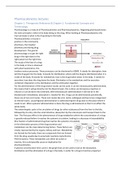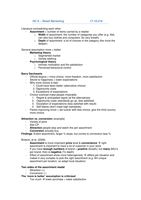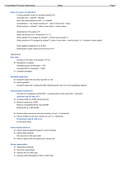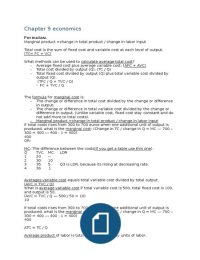Tutorial (week 1 )
Wednesday, November 14, 2018 12:47 AM
Chapter 1
1. Provide a definition of development economics. Justify your choice carefully
Thus, development economics, to a greater extent than traditional neoclassical economics or even
political economy, must be concerned with the economic, cultural, and political requirements for
effecting rapid structural and institutional transformations of entire societies in a manner that will
most efficiently bring the fruits of economic progress to the broadest segments of their populations
2. Is it possible that there could be growth of per capita income without achievement of other
objectives, such as poverty reduction and the growth of self-esteem?
3. Do you think it is in the material interests of high-income countries to help low-income countries
improve their economic performance? Why or why not?
4. How does the concept of “capabilities to function” help us gain insight into development goals
and achievements? Is money enough? Why or why not?
5. How is happiness related to development?
Clearly, happiness is part of human well-being, and greater happiness may in itself expand an individual’s
capability to function. As Amartya Sen has argued, a person may well regard happiness as an important
functioning for her well-being.15 In recent years, economists have explored the empirical relationship across
countries and over time between subjectively reported satisfaction and happiness and factors such as income.
One of the findings is that the average level of happiness or satisfaction increases with a country’s average
income
6. What are the most important characteristics that have shaped Brazil’s economic and social
progress during the last three decades?
Chapter 2
7. Explain how low levels of living can turn into a vicious cycle in developing countries.
8. Carefully explain some of the similar problems faced by otherwise diverse countries in Africa,
Asia, and Latin America.
Global Devlopment Studies Page 1
,9. Explain why purchasing power parity measures of income levels tend to show a smaller
difference between poor and rich countries compared to exchange rate measures of income levels.
10. Go to http://hdr.undp.org/en/2018-update and find the HDI ranking of South Africa and Cuba.
Contrast and explain the HDI ranking to per capita income (in PPPs) in South African and Cuba.
11. How does the HDI adjust for diminishing marginal utility of income?
12. How is absolute poverty measured? What is the extent of poverty in the developing world?
Absolute poverty refers to the state in which an individual cannot afford a basic subsistence
level i.e. is insufficient in basic necessities of life like food, clothing and shelter. Since income
and food consumption are the most important criteria to check on well being of an individual,
they are used to define what we call as a poverty line.
Poverty line is a threshold level that defines individuals living in absolute poverty as the ones
living below it. They are the ones who are unable to meet basic human needs.
However, this minimum income or consumption threshold needed for a healthy living would
differ from society to society. For instance, there has to be a different threshold of poverty
for people living in metros vis a vis in villages given that the living cost differ highly in the two
regions or between USA and India given that two countries differ in many aspects such as
population, development, infrastructure etc.
That is where the concept of relative poverty comes into picture. It is a concept that refers to
the phenomenon of relative deprivation. It measures the degree of poverty. It refers to
individuals or groups that lack in resources when compared with other members of the
society they belong to.
That is why, there can be cases where people in relative poverty group might be living above
subsistence level i.e. though such people are able to maintain a basic minimum living
standard but then no way are their conditions good enough in regards to the society they live
in .
Thus, the difference between the two concepts stems out of absolute level of deprivation
(absolute poverty) and culturally defined standard of living (relative poverty).
From <https://www.quora.com/What-is-the-difference-between-absolute-poverty-and-relative-poverty>
Global Devlopment Studies Page 2
, From <https://www.quora.com/What-is-the-difference-between-absolute-poverty-and-relative-poverty>
13. In what way(s) do the development paths chosen by Pakistan and Bangladesh differ? What are
the main factors that have contributed to these differing paths?
Global Devlopment Studies Page 3
Wednesday, November 14, 2018 12:47 AM
Chapter 1
1. Provide a definition of development economics. Justify your choice carefully
Thus, development economics, to a greater extent than traditional neoclassical economics or even
political economy, must be concerned with the economic, cultural, and political requirements for
effecting rapid structural and institutional transformations of entire societies in a manner that will
most efficiently bring the fruits of economic progress to the broadest segments of their populations
2. Is it possible that there could be growth of per capita income without achievement of other
objectives, such as poverty reduction and the growth of self-esteem?
3. Do you think it is in the material interests of high-income countries to help low-income countries
improve their economic performance? Why or why not?
4. How does the concept of “capabilities to function” help us gain insight into development goals
and achievements? Is money enough? Why or why not?
5. How is happiness related to development?
Clearly, happiness is part of human well-being, and greater happiness may in itself expand an individual’s
capability to function. As Amartya Sen has argued, a person may well regard happiness as an important
functioning for her well-being.15 In recent years, economists have explored the empirical relationship across
countries and over time between subjectively reported satisfaction and happiness and factors such as income.
One of the findings is that the average level of happiness or satisfaction increases with a country’s average
income
6. What are the most important characteristics that have shaped Brazil’s economic and social
progress during the last three decades?
Chapter 2
7. Explain how low levels of living can turn into a vicious cycle in developing countries.
8. Carefully explain some of the similar problems faced by otherwise diverse countries in Africa,
Asia, and Latin America.
Global Devlopment Studies Page 1
,9. Explain why purchasing power parity measures of income levels tend to show a smaller
difference between poor and rich countries compared to exchange rate measures of income levels.
10. Go to http://hdr.undp.org/en/2018-update and find the HDI ranking of South Africa and Cuba.
Contrast and explain the HDI ranking to per capita income (in PPPs) in South African and Cuba.
11. How does the HDI adjust for diminishing marginal utility of income?
12. How is absolute poverty measured? What is the extent of poverty in the developing world?
Absolute poverty refers to the state in which an individual cannot afford a basic subsistence
level i.e. is insufficient in basic necessities of life like food, clothing and shelter. Since income
and food consumption are the most important criteria to check on well being of an individual,
they are used to define what we call as a poverty line.
Poverty line is a threshold level that defines individuals living in absolute poverty as the ones
living below it. They are the ones who are unable to meet basic human needs.
However, this minimum income or consumption threshold needed for a healthy living would
differ from society to society. For instance, there has to be a different threshold of poverty
for people living in metros vis a vis in villages given that the living cost differ highly in the two
regions or between USA and India given that two countries differ in many aspects such as
population, development, infrastructure etc.
That is where the concept of relative poverty comes into picture. It is a concept that refers to
the phenomenon of relative deprivation. It measures the degree of poverty. It refers to
individuals or groups that lack in resources when compared with other members of the
society they belong to.
That is why, there can be cases where people in relative poverty group might be living above
subsistence level i.e. though such people are able to maintain a basic minimum living
standard but then no way are their conditions good enough in regards to the society they live
in .
Thus, the difference between the two concepts stems out of absolute level of deprivation
(absolute poverty) and culturally defined standard of living (relative poverty).
From <https://www.quora.com/What-is-the-difference-between-absolute-poverty-and-relative-poverty>
Global Devlopment Studies Page 2
, From <https://www.quora.com/What-is-the-difference-between-absolute-poverty-and-relative-poverty>
13. In what way(s) do the development paths chosen by Pakistan and Bangladesh differ? What are
the main factors that have contributed to these differing paths?
Global Devlopment Studies Page 3










